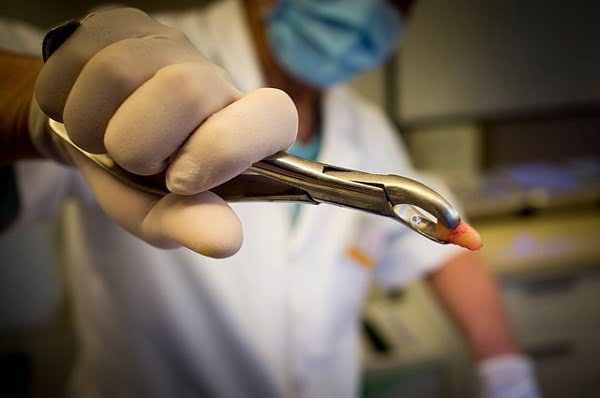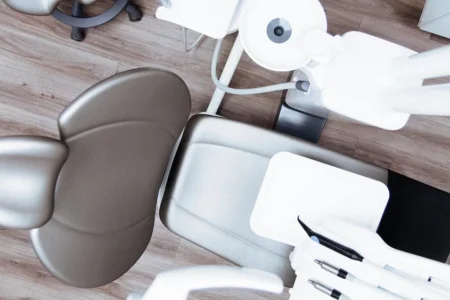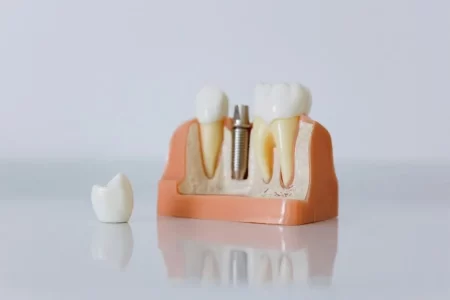
What cause loose teeth?
Imagine the journey of periodontitis as a cascading domino effect, with plaque as the first tile. This sticky, bacteria-rich film forms on your teeth when the remnants of your meals, rich in sugars and starches, mingle with bacteria native to your mouth. While daily brushing and flossing can push back against plaque, it’s persistent and makes frequent comebacks.
If neglected, plaque hardens into tartar, a stubborn substance that sets up camp beneath your gumline. Unlike its predecessor, tartar can’t be ousted with regular brushing or flossing – only a dentist’s skilled hand can tackle it. Both plaque and tartar, being bacterial havens, wreak havoc the longer they remain.
Enter gingivitis, the introductory act of gum diseases. This condition results in irritated and swollen gum tissues, or ‘gingiva’. The silver lining? Gingivitis can be reversed, but only with timely professional intervention and diligent home care, especially before bone damage sets in.
If the gums continue to endure inflammation, periodontitis is the grim finale. This condition carves deep pockets between gums and teeth, which fill up with the notorious trio: plaque, tartar, and bacteria. These pockets deepen and, if overlooked, lead to tissue and bone loss, risking tooth loss. Furthermore, the persistent inflammation can strain the immune system, potentially leading to more health issues.
Can a loose tooth be saved or fixed? Can a dentist fix a loose tooth?
A loose tooth is a problem faced by many people. People may experience loose front tooth, loose molars or loose both teeth. One might worry can a loose tooth be saved? Can you fix a loose tooth? Can a loose tooth be fixed? The answer to this question is a simple Yes.
Loose Tooth Remedy: What are the ways for treating loose teeth?
There are various methods that can help tighten or fix a loose tooth or a wobbly tooth. Some of them are discussed here.
Deep Cleaning
Due to bad eating habits and bad oral practices, bacteria may infect the gums leading to the formation of pockets. And these pockets may cause a loose tooth. A loose tooth can be fixed by deep cleaning of these pockets to remove the bacteria. This cleaning process is known as scaling.
In a scaling process, the accumulated tartar is scraped off the gum line. Then, membranes or tissue-stimulating proteins are used to stimulate the healing of gums and tissues. The healing process strengthens the gums and also tightens the loose teeth. After deep cleaning, it is highly recommended to follow a good oral hygiene.
Root Planing
Root planing is done on the early onset of gum diseases when the loosening of teeth has just started. In this procedure, the tooth is reshaped by removing all the rough spots which will prevent any further building up of germs. Any remaining tartar or plaque is removed with the help of a laser.
If good dental hygiene is followed after this method, the progression of any gum disease can be prevented. This will strengthen the gums and help to fix the teeth.
Antibiotic Treatment: Can a loose tooth heal with antibiotic treatment?
The root cause of loose teeth is gum diseases. Painful gums and chronic bad breath (apart from food) can also be caused by gum diseases. Also, gum disease can lead to various other problems. The bacteria that cause the gum disease may enter the body and may cause other illnesses too. Heart disease, stroke, bodily infections and premature births are some of the problems which can be caused by periodontal diseases. Therefore, the first thing that should be done is to control the gum infection. This can be done by antibiotics. In serious cases, sometimes, antibiotics can even be placed right on the gum for quick relief by your doctor for teeth tightening.
Bone Grafts
This shaking teeth treatment involves cleaning of the roots of the loose teeth and filling the pockets. The pockets are filled with a bone graft that is made from patient’s own bone and tissue. It helps in loose tooth repair. Bone grafts are also helpful to strengthen gums and tighten loose teeth.
Dental splint for loose teeth: Will my loose teeth tighten up with splints?
In case of very loose teeth, they are joined together like pickets in a fence which help in distributing the biting force among the group of teeth joined together. It reduces the biting force on the loosened teeth. Dental splints can be used in three different ways: temporary splinting, permanent splinting and occlusal splints.
Temporary splinting to tighten loose teeth
Temporary splinting, used to tighten loose teeth, involves joining the teeth together with:
Extra-coronal splints
In this term, “extra” refers to outside of the teeth and “coronal” means crown. This approach involves attaching of the splinting material to a group of teeth by bonding to the enamel (outside). The technique makes the teeth more rigid.
Intra-coronal splint
In this term, “intra” refers to inside of the teeth. In this procedure, a small channel is cut into the teeth. A rigid custom-formed metal splint is inserted into the cut and is cemented in place in order to stabilize the teeth.
Permanent or fixed splinting
This is the permanent method of splinting. The method involves crowing the loosened teeth and fabricating a splint (in which the crowns are fused together).
Occlusal splints or guards
If the patient suffers from bruxism (clenching and grinding of teeth) also, then a removable splint is recommended to protect the teeth and as a measure for loose teeth cure. Removable splints can be easily used whenever required (at the time of teeth grinding like at night) and they are very useful to fix the loose tooth.
Tooth glue for loose tooth
Tooth glue or dental glue is a slang term used for the over-the-counter dental cement. This is not a long-term solution but can be used in an emergency. They are pretty effective when someone wishes to temporarily fix the chipped teeth and broken crowns. It is always good to talk to the dentist before using the tooth glue.






